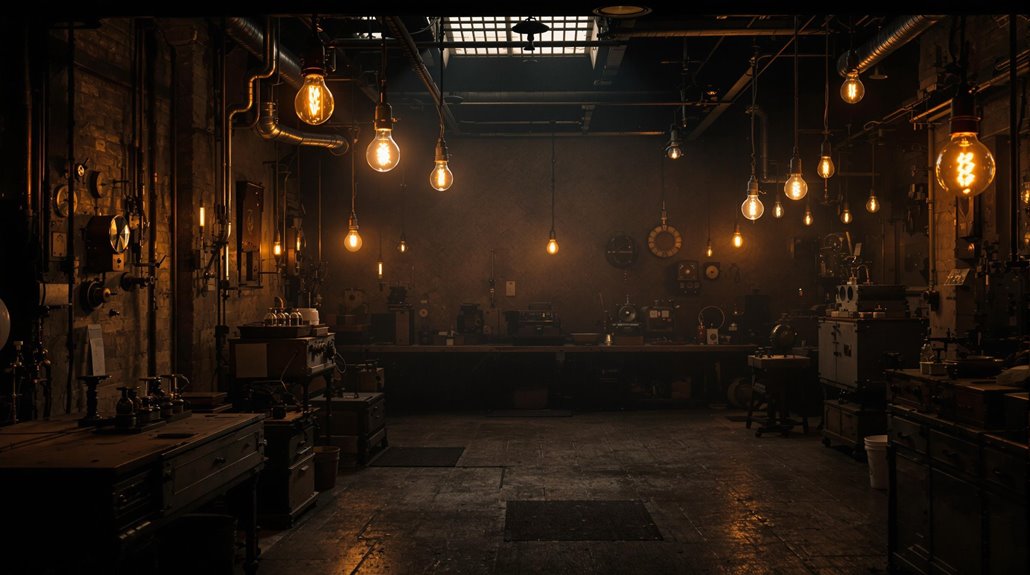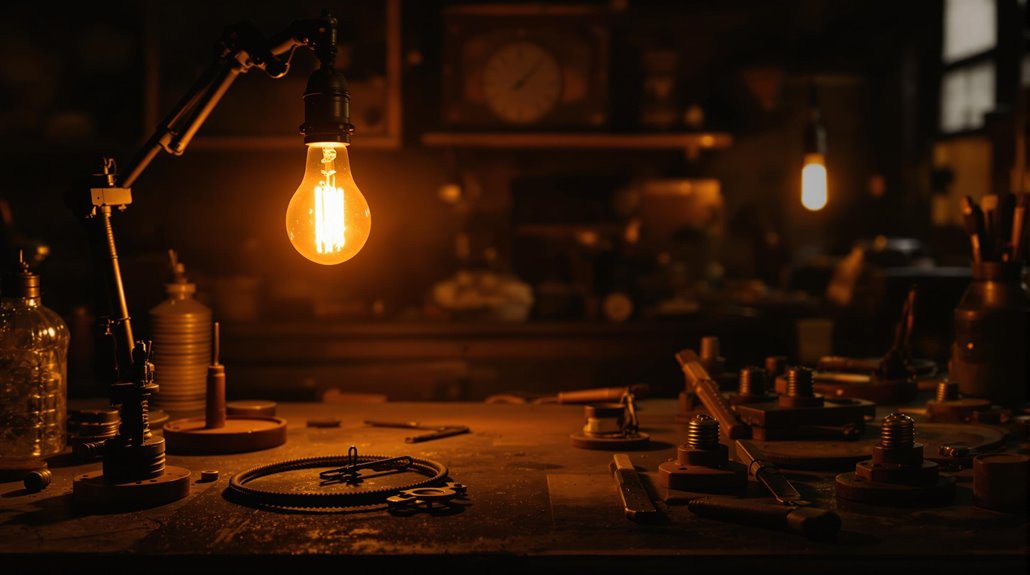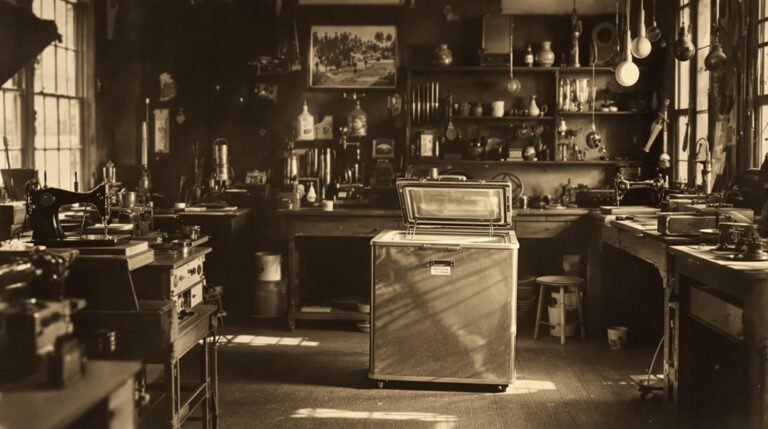The Great Light Bulb Conspiracy: When Companies Planned Obsolescence
Imagine unwrapping a new light bulb in 1924, carefully screwing it into your fixture, and watching it burn out just weeks later – far sooner than bulbs you'd bought just years before. You weren't imagining things. A secret cartel of manufacturers had deliberately engineered their products to fail, marking one of history's most brazen examples of corporate manipulation. The story of the Phoebus cartel reveals how companies conspired to keep you buying more, and their tactics haven't disappeared – they've just evolved.
The Birth of a Shadowy Alliance: Understanding the Phoebus Cartel

The cartel dynamics were carefully orchestrated: members received shares based on their lamp sales, while a supervisory body controlled global operations.
Of historical significance was the cartel's 30-year plan to dominate the worldwide incandescent light bulb market.
You'd be surprised to learn they didn't just standardize production and pricing – they carved up entire markets, assigning specific zones to manufacturers and establishing strict production quotas for each member.
Their most controversial policy required manufacturers to limit bulb lifetimes to 1,000 hours despite the capability to produce longer-lasting products.
The organization evolved from the Internationale Glühlampen Preisvereinigung, a predecessor group founded by Osram in 1921.
Engineering Failure: How 2,500 Hours Became 1,000
Once the Phoebus Cartel secured its market control, its members launched a systematic engineering campaign to reduce light bulb lifespans.
Through precise technical modifications, they altered filaments, adjusted voltages, and changed gas mixtures to deliberately shorten bulb life – a clear violation of engineering ethics and consumer rights.
You'd be shocked to learn how methodically they degraded their own product. In 1924, bulbs lasted 2,500 hours, but by 1940, they'd cut that lifespan to just 1,000 hours.
Their central testing laboratory in Switzerland enforced these standards religiously, imposing fines on any factory exceeding the limits.
Modern LED technology has proven this manipulation unnecessary, with bulbs capable of 50,000 hours of operation.
Major manufacturers like Osram and Philips participated in this market manipulation, setting strict production quotas to maintain control.
Instead of innovating for better efficiency, they focused entirely on perfecting planned obsolescence.
They suppressed patents for longer-lasting bulbs and redirected research toward ensuring their products would fail predictably.
Money, Power, and Market Control: The Economics Behind the Scheme
While engineering failures drove the Phoebus cartel's technical strategy, pure profit motivation fueled their economic scheme.
Through economic manipulation, major manufacturers like GE, Osram, and Philips controlled 90% of the global light bulb market, turning consumer exploitation into an art form. The practice became a pioneering example of planned obsolescence, setting a precedent that would influence manufacturing for decades to come.
You might wonder how they pulled it off. Here's what made their scheme successful:
- They standardized specifications across all member companies, ensuring no one could offer better products.
- They marketed inferior bulbs as "higher quality," deceiving consumers while raising prices.
- They implemented strict testing protocols to maintain the 1,000-hour limit, preventing competition through quality.
The results were staggering – sales jumped from 335.7 to 420.8 million units within four years, while profits soared thanks to lower production costs and artificially inflated prices. Similar to modern tech companies, they established a two to three year replacement cycle that forced consumers to keep buying their products.
Breaking the Trust: Legal Battles and Industry Fallout
After decades of market manipulation, legal scrutiny finally caught up with the Phoebus cartel in 1949 when a U.S. District Court found General Electric guilty of violating the Sherman Anti-Trust Act.
The legal repercussions were swift, forcing GE to abandon the cartel, which led to the group's eventual dissolution.
While the UK's 1951 Monopolies Commission disputed claims of planned obsolescence, arguing there's no "absolutely right life" for bulbs, the cartel's actions told a different story.
They'd actively enforced shorter lifespans through a strict system of fines and testing at their Swiss facility.
The impact on consumer rights was significant – you'd gone from bulbs lasting 2,500 hours in 1924 to just 1,000 hours by 1940.
This practice of planned obsolescence didn't end with the cartel's demise but spread to other industries. The cartel's original goal was to continue operations until 1955 as planned, but World War II disrupted their activities.
The shift away from longevity marked a stark contrast to early manufacturing, when light bulbs were designed specifically for durability and extended use.
From Fiction to Documentary: The Cartel's Cultural Impact

The Phoebus cartel's legacy lives on through powerful cultural works that exposed its secretive practices to wider audiences.
You'll find a scathing cultural critique in Thomas Pynchon's "Gravity's Rainbow," where Byron the Bulb serves as a symbol of resistance against corporate manipulation.
The 2010 documentary "The Light Bulb Conspiracy" further amplified consumer awareness by investigating planned obsolescence across three continents.
Modern electronics generate 40 million tons of e-waste globally each year due to rapid product turnover.
 culture of disposability that has come to define modern consumer behavior.
culture of disposability that has come to define modern consumer behavior.
These works continue to shape public discourse by:
- Highlighting the conflict between profit-driven business and environmental responsibility
- Inspiring discussions about sustainable manufacturing and resource efficiency
- Serving as cautionary tales in modern debates about corporate ethics
The cartel's story remains relevant today, influencing how you think about product longevity and corporate responsibility in an age of increasing environmental concerns.
Modern Echoes: Planned Obsolescence in Today's Tech World
Modern planned obsolescence has evolved far beyond light bulbs, manifesting most prominently in today's tech industry.
You'll notice smartphone slowdown when manufacturers push updates that bog down older models, compelling you to upgrade. Many devices now use pentalobe screws to prevent consumers from accessing internal components.
Printer pitfalls reveal themselves through non-refillable cartridges and firmware that rejects third-party alternatives.
The problem extends beyond electronics.
Fashion waste piles up as clothing companies design garments to fall apart after minimal wear, pushing you toward constant replacements.
Meanwhile, e-waste dilemmas grow more pressing as discarded devices containing precious metals and rare earth elements overwhelm recycling capabilities.
Today's right-to-repair movement echoes the century-old light bulb controversy, as consumers fight back against manufacturers who deliberately design products with shortened lifespans and limited repairability.










